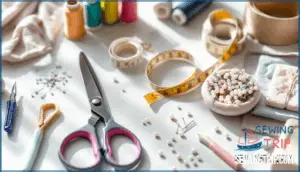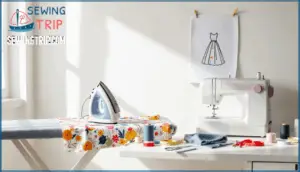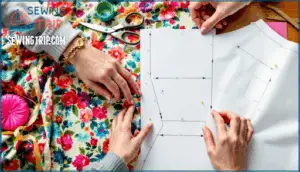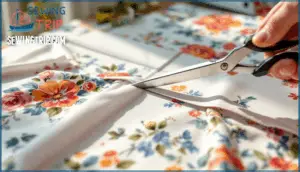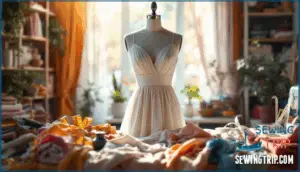This site is supported by our readers. We may earn a commission, at no cost to you, if you purchase through links.
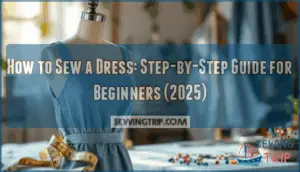 Your first handmade dress doesn’t need to be perfect. It just needs to be yours. That shift in mindset transforms sewing from an intimidating craft into an achievable skill that starts with choosing the right pattern and fabric combination.
Your first handmade dress doesn’t need to be perfect. It just needs to be yours. That shift in mindset transforms sewing from an intimidating craft into an achievable skill that starts with choosing the right pattern and fabric combination.
Beginners often stumble by selecting designs that are too complex or materials that won’t cooperate with their vision. The real secret lies in understanding how pattern simplicity works with forgiving fabrics like cotton or linen.
When you match a straightforward design to beginner-friendly materials, you set yourself up for a finished garment that looks intentional and feels like an accomplishment worth wearing.
Table Of Contents
Key Takeaways
- Selecting simple beginner patterns paired with forgiving fabrics like cotton or linen creates the foundation for success when you’re learning to sew your first dress.
- Accurate fabric preparation through pre-washing and precise cutting along the grain line prevents common issues like shrinkage and twisted seams in your finished garment.
- Essential construction techniques including darts for shaping, proper seam finishing to prevent fraying, and careful pressing at each stage transform flat fabric pieces into a professional-looking wearable dress.
- Building sewing confidence comes from choosing patterns that match your current skill level and treating mistakes as learning opportunities rather than failures.
Choose The Right Dress Pattern and Fabric
Picking the right pattern and fabric sets the stage for your entire sewing project. The pattern you choose determines the fit and style while the fabric brings your vision to life.
Let’s break down how to select both so your first dress turns out exactly as you imagined.
Types of Dress Patterns for Beginners
Your first dress pattern should keep things simple. Look for beginner sewing patterns with straightforward shapes like shift dresses or t-shirt styles. These dress patterns skip tricky elements like zippers and buttons.
Choose designs with fewer pieces and simple closures. Wrap dresses work well because they adjust to fit your body. Tunic patterns give you room to breathe while you’re learning dressmaking basics.
For a simple project, consider a beginner-friendly tunic like the Stevie Tunic.
How to Select Suitable Fabrics
Once you’ve picked a pattern, choosing the right fabric makes or breaks your first dress. Cotton and linen suit beginners best because they’re easy to work with and don’t slip around during cutting. Fabric weight matters for your design—light fabrics under 136 gsm flow beautifully for summer styles while medium weights give structure. The garment’s functionality is a critical factor, affecting its performance and wearability.
Consider these practical factors for fabric selection:
- Fiber content affects how your dress wears and washes
- Seasonal considerations guide breathability and warmth
- Fabric cost varies widely, with synthetics offering budget-friendly options
Check your pattern envelope for fabric recommendations before you shop.
Matching Pattern and Fabric for Style
Your fabric choice needs to play nice with your pattern’s design, or you’ll end up fighting your dress from the first stitch. Fabric drape determines whether your pattern complexity works—stiff fabrics won’t flow in gathered styles while floppy materials can’t maintain structure.
Match your color palettes and seasonal fabrics to your dress pattern’s intended look. Choosing the right fabric for your sewing patterns creates style cohesion that makes your finished garment look intentional.
Gather Essential Tools for Dressmaking
Before you start cutting fabric, you need the right tools on hand. Having your supplies ready means you won’t lose momentum halfway through a seam or struggle with pins that don’t grip.
Must-Have Sewing Supplies
Before you can transform fabric into something beautiful, you need the right tools in your hands. Start with a basic sewing kit that includes sharp fabric scissors, pins, hand needles, and a seam ripper.
You’ll also need measuring tape, a ruler, and fabric marking tools like chalk or washable pens. Don’t forget thread in various colors and quality pressing tools like an iron.
Preparing Your Sewing Space
Setting up a dedicated space transforms your sewing from scattered chaos into smooth progress. Your beginner sewing guide starts with organizing these three essentials:
- Ergonomic setup – Position your sewing machine at elbow height to prevent shoulder strain during long sessions
- Lighting considerations – Add bright task lighting from multiple angles so you can see every stitch clearly
- Storage solutions – Keep fabric organized in bins and thread on wall racks for quick access
Good lighting and smart fabric organization make every project easier.
Understanding Sewing Machine Basics
Learning your machine’s basic functions now saves you from frustration when you’re halfway through sewing a dress. Start with machine threading and bobbin winding to get smooth stitches every time. Practice stitch selection between straight and zigzag stitch on scrap fabric. Adjust tension settings until your seams look balanced on both sides.
Basic maintenance like cleaning lint keeps your sewing machine running perfectly as you develop your sewing skills.
Prepare and Cut Fabric Accurately
Getting your fabric ready is where precision meets preparation. Before you can start stitching your dress together, you need to prep your material and cut each piece with care.
Here’s how to set yourself up for sewing success.
Pre-Washing and Ironing Fabric
Your fabric might shrink or twist the first time it hits water, so washing it now saves you from a dress that mysteriously shrinks two sizes after its debut wear. Wash textiles the same way you’ll care for the finished dress to avoid color bleeding.
Skip fabric softening since it can interfere with your sewing machine’s grip. Once dry, press with the right iron temperature to prevent wrinkles and make cutting accurate.
Laying Out and Pinning Pattern Pieces
Spread your fabric flat with the grain line running straight, and you’ll turn those flimsy paper pieces into a roadmap for your dream dress. Match the grain direction arrows on your pattern with the fabric’s lengthwise threads to prevent twisted seams later.
Pin at corners first, then along edges every few inches. Smart pattern placement minimizes fabric waste while respecting seam allowances and weaving pieces together like puzzle parts.
Cutting Fabric for Precision
Sharp fabric shears glide through fabric differently than dull ones—the difference between a clean edge and a frayed mess that throws off your entire fit.
Cut along pattern lines with long, smooth strokes while keeping your free hand flat on the fabric for stabilizing. Follow seam allowances precisely and never lift the fabric off your cutting surface.
Sew The Dress Step by Step
Now that your pieces are cut and ready, it’s time to bring your dress to life. This is where you’ll connect all those fabric sections and watch them transform into something you can actually wear.
The following steps will walk you through each stage of construction from start to finish.
Assembling Bodice and Skirt Sections
The bodice and skirt come together like two puzzle pieces that transform flat fabric into the recognizable shape of a dress. Start by pinning the pieces right sides together at the waistline. Pay attention to these key steps:
- Match side seams and center marks for proper seam alignment before pinning
- Adjust skirt gathers evenly across the waistband attachment if your pattern includes them
- Pin bodice fitting areas carefully to maintain the garment construction integrity
- Stitch slowly following step-by-step video instructions for lining integration when included
This joining creates the foundation of your dress.
Sewing Darts, Pleats, and Seams
Darts, pleats, and seams give your flat fabric pieces dimension and shape—the secret behind a dress that actually fits your body.
Sew darts first by folding fabric along marked lines and stitching to the point for a tapered finish. Press them flat toward the center.
For pleats, fold fabric at markings and baste across the top.
Stitch seams with a straight stitch and finish raw edges with a zigzag or serger to prevent fraying.
Attaching Facings, Sleeves, and Zippers
Once you’ve shaped the fabric with darts and seams, facings, sleeves, and zippers turn your dress into something you can actually wear and finish with polish.
Attach facings by stitching right sides together along necklines or armholes. Understitch to keep them flat and invisible.
For sleeves, pin and ease the cap into the armhole before sewing.
Install invisible zippers before sewing side seams for a clean finish.
- Facing techniques stabilize necklines and create professional edges
- Sleeve options range from set-in to raglan styles for different fits
- Zipper types include invisible and centered applications for various closures
These step-by-step video instructions at Sew It Academy guide you through each technique when sewing a dress.
Finishing Side Seams and Armholes
After zippers are in and sleeves are set, side seams and armholes need clean finishing to prevent fraying and give your dress that store-bought feel.
Try a serger for quick edges or use bias binding for woven fabrics. French seams work beautifully on lightweight materials.
These armhole techniques and seam finishes transform raw edges into professional details that last through countless wears.
Hemming and Final Pressing
Your dress is nearly finished—now hemming sets the length and final pressing brings everything into sharp alignment. Choose a hem finish that suits your fabric—blind hemming for invisible stitches or topstitching for casual looks. Press curved hems carefully with steam to avoid puckering.
- Blind hemming creates invisible stitches that disappear into the fabric
- Curved hems need gentle steam and patience to lie flat without waves
- Understitching facings before pressing keeps edges crisp and professional
- Pressing techniques using a tailor’s ham shape contours perfectly into place
These essential sewing techniques complete your step-by-step sewing guide with final touches that make all the difference.
Tips for Dressmaking Success
You’ve completed your first dress and that’s a huge accomplishment. Now let’s talk about how to make every project after this one smoother and more enjoyable.
Here are three practical ways to build your skills and tackle challenges as they come up.
Troubleshooting Common Sewing Issues
When your machine acts up, don’t panic. Thread breakage often stems from incorrect threading or excessive tension. Skipped stitches signal a dull needle or improper threading. Fabric jamming happens when you start too close to the edge or leave thread tails shorter than six inches. Seam puckering means your tension needs adjustment.
Machine maintenance matters—clean out lint regularly and oil moving parts. These sewing techniques become second nature with practice.
Choosing Easy Patterns for Practice
Start with simple dress patterns that strip away the intimidation factor. Look for beginner-friendly designs that teach you skills without overwhelming you.
Perfect practice pattern features:
- Minimal pattern pieces – Four to six pieces total keep your first dress patterns manageable.
- Elastic waistbands – Skip zippers entirely during your beginner project phase.
- Loose silhouettes – Easy sewing means forgiving fits that hide small mistakes.
- Straight seams – Beginner sewing patterns with minimal curves build your confidence fast.
Easy alterations come naturally when pattern complexity levels match your current skills.
Building Confidence With Each Project
Every finished dress you complete adds another layer of skill to your sewing foundation. Track your skill progression through photos of each beginner project you finish. Celebrate successes no matter how small they seem.
Your learning curve flattens naturally when you choose step-by-step video instructions that match your current abilities. Overcoming fear happens through doing. Building sewing confidence and sewing skills development come from consistent project selection that challenges you just enough without crushing your momentum.
Sewing for beginners means progress over flawlessness.
Frequently Asked Questions (FAQs)
How do you make a dress by sewing?
Making a dress by sewing involves selecting a dress pattern suited for beginners, choosing fabric that matches the design, cutting pieces along the fabric grain, assembling sections with seams and darts, adding fitting adjustments, and finishing with hems—a step-by-step sewing guide transforms dressmaking into achievable design customization.
How do you sew a dress on a sewing machine?
Thread your machine and select a straight stitch. Adjust tension settings and choose the right needle for your fabric.
Follow step-by-step video instructions for sewing seams with proper seam finishes. Press each section as you progress.
How long does it take to sew a dress?
Project complexity and skill level matter most. Simple projects with beginner sewing patterns take four to eight hours. Fabric type and pattern intricacy add time.
Available time shapes your pace. Break dressmaking projects into manageable sessions for steady progress.
Is it difficult to sew a dress?
Sewing a dress isn’t difficult if you match pattern complexity with your skill level. Beginner sewing patterns with simple projects minimize fabric challenges and common mistakes. A step-by-step sewing guide reduces time commitment and builds confidence naturally.
How can I learn to sew a dress?
Online academies like Sew It Academy transform complete beginners into confident sewers through step-by-step sewing guides and dress sewing patterns. You’ll master fabric selection, pattern adjustments, and skill development while connecting with a supportive sewing community that guides your weaving journey.
How do you sew a dress lining?
Lining fabric choice matters most when you select lightweight materials that match your dress weight.
Attaching the lining involves pinning it wrong sides together and stitching neckline and armholes, then using understitching techniques to keep seams flat inside.
What Type of Thread Should I Use for Sewing Dresses?
Use all-purpose polyester thread for most dress fabrics. Cotton blend works beautifully with natural fibers like cotton and linen.
Match thread weight to your dress fabric weight. Lightweight fabrics need finer thread, while heavier weaving requires stronger options.
How Can I Hem My Dress if I Don’t Have a Sewing Machine?
You’ll be amazed how beautifully you can finish a hem without any machine at all. Hand-sewing hems with a simple slip stitch creates invisible results.
Fusible hem tape bonds fabric with an iron. Fabric glue offers temporary hems for quick fixes.
What’s the Best Way to Cut Out My Dress Pieces Accurately?
Place your pattern pieces on fabric with grain lines aligned perfectly. Use sharp fabric scissors and cut confidently in long, smooth strokes.
Pin pattern pieces securely and mark notches with tailor’s chalk for precision cutting success.
Can a beginner sew a dress?
Yes. Beginner sewing patterns with clear instructions make dressmaking accessible. Start with simple designs requiring minimal skill. Expect longer project time initially. Cost remains reasonable with basic materials. Set realistic expectations and follow beginner-focused patterns for success.
Conclusion
What if the difference between frustration and pride comes down to that first successful seam? When you learn to sew a dress with patience and the right foundation, each stitch builds more than fabric—it builds confidence. Your mistakes become lessons instead of failures.
Start simple, trust the process, and remember that every expert once struggled with their first zipper. The dress you finish today is proof you’re capable of creating something beautiful with your own hands.
- https://www.grandviewresearch.com/industry-analysis/sewing-machine-market-report
- https://www.businessresearchinsights.com/market-reports/sewing-and-quilting-market-118753
- https://www.maximizemarketresearch.com/market-report/sewing-machine-market/84626/
- https://pineconesandcactus.com/2025/01/08/sewing-expenses-and-data-from-2024/
- https://www.thumbtack.com/p/seamstress-prices

